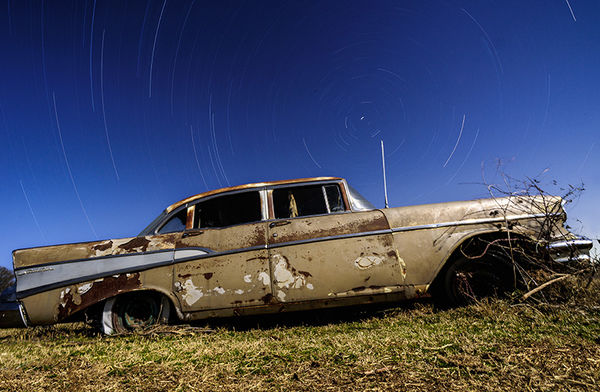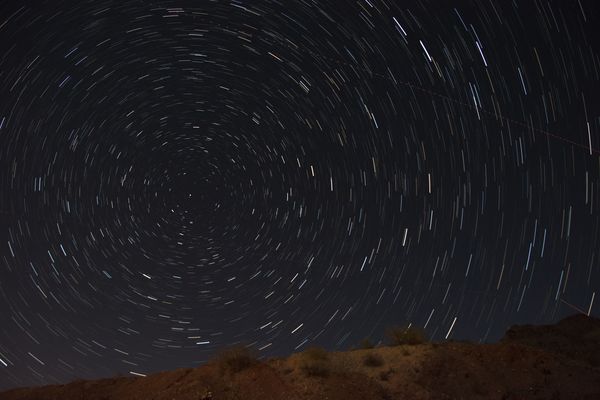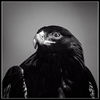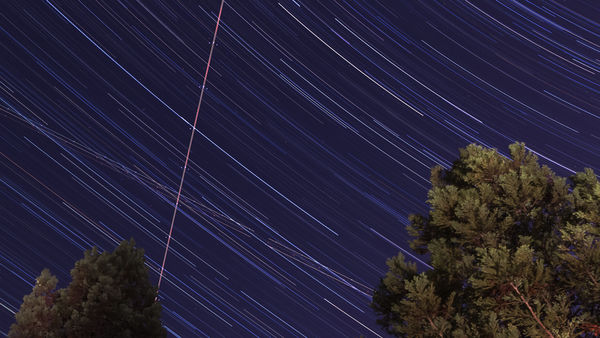Long Exposure Methods and Star Trails
Feb 12, 2017 21:23:15 #
Question 1)
I shoot star trails usually with 30" exposures and a 3 second interval. That creates a lot of files and takes up a lot of disk space. Lately, I've been trying longer exposures such as 8', 16', or 32'. It seems that when I use longer exposures, I get fainter and thinner trails as in the picture. Now, I realize that I'm pointed north and using a very wide angle lens (14mm) so, it takes longer to get more trails. This is 4 32' exposures at f/16, ISO 100, with a 1 second interval stacked in CS6 on a D810. Total time is 2:08. Why the fainter and thinner trails.
Question 2)
I had a D3s going at the same time with 30" exposure with 1" interval using the internal intervalometer (why is there no electronic dictionary on the internet that can spell that?). Started out using the Phottix intervalometer with it but it never gave me consistent exposure times. They would range anywhere from a few seconds to the full time (You set an exposure time and interval separately as opposed to using both as one value). If I use the internal software, with a 3 second interval, works fine. But if I go to a 1 second interval, I have issues. I looked at how many exposures I got and given the time it was running, I should've had 75 to 100 more. The trails had very noticeable gaps in them and were very square looking. So, to make a long story longer, I'm thinking that the D3s (as great of a camera as it is), has problems buffering files with long exposures and short intervals since I can't get it to work either way.
So, I wanted to know everyone's thoughts on that. Especially those who shoot a lot of night sky stuff.
I shoot star trails usually with 30" exposures and a 3 second interval. That creates a lot of files and takes up a lot of disk space. Lately, I've been trying longer exposures such as 8', 16', or 32'. It seems that when I use longer exposures, I get fainter and thinner trails as in the picture. Now, I realize that I'm pointed north and using a very wide angle lens (14mm) so, it takes longer to get more trails. This is 4 32' exposures at f/16, ISO 100, with a 1 second interval stacked in CS6 on a D810. Total time is 2:08. Why the fainter and thinner trails.
Question 2)
I had a D3s going at the same time with 30" exposure with 1" interval using the internal intervalometer (why is there no electronic dictionary on the internet that can spell that?). Started out using the Phottix intervalometer with it but it never gave me consistent exposure times. They would range anywhere from a few seconds to the full time (You set an exposure time and interval separately as opposed to using both as one value). If I use the internal software, with a 3 second interval, works fine. But if I go to a 1 second interval, I have issues. I looked at how many exposures I got and given the time it was running, I should've had 75 to 100 more. The trails had very noticeable gaps in them and were very square looking. So, to make a long story longer, I'm thinking that the D3s (as great of a camera as it is), has problems buffering files with long exposures and short intervals since I can't get it to work either way.
So, I wanted to know everyone's thoughts on that. Especially those who shoot a lot of night sky stuff.

Feb 13, 2017 10:06:24 #
Ny5y
Loc: Mississippi
From what I have read you may have high ISO noise reduction on. This needs to be turned off.
Feb 13, 2017 10:19:43 #
When I shoot star trails, I use an intervalometer, but I don't mess with the settings on the intervalometer. I set the camera up to take 30 second exposures, and make sure the camera's drive setting is in high speed burst. Then, I simply use the intervalomter's shutter lock, and have it go for as long as I like. I make sure the camera's long exposure noise reduction is turned off. If it is turned on, the camera will do its noise reduction activity between the shots, which will cause a delay between shots. (This part is critical.)
Also, when I shoot star trails, I set up the camera to take small raw shots. My cameras will take three different size raw shots. For everything else, I'll take full size raw shots, but for star trails, I'll go with the small size. I still have full control over the editing of the shots, but it doesn't take up as much space. Then, all I have to do is edit one shot, in Lightroom, and batch up the rest.
Once I have the end composite shot, I throw away all the individual shots, since I never intend to use them, again. Of course, the drawback to that approach is that EXIF data is lost, forever.
Even with this continuous shooting, there are still tiny gaps between the individual exposure trails. I have to use some software to smooth it out. StarStax was what I found, online. If I recall, it was free.
Also, when I shoot star trails, I set up the camera to take small raw shots. My cameras will take three different size raw shots. For everything else, I'll take full size raw shots, but for star trails, I'll go with the small size. I still have full control over the editing of the shots, but it doesn't take up as much space. Then, all I have to do is edit one shot, in Lightroom, and batch up the rest.
Once I have the end composite shot, I throw away all the individual shots, since I never intend to use them, again. Of course, the drawback to that approach is that EXIF data is lost, forever.
Even with this continuous shooting, there are still tiny gaps between the individual exposure trails. I have to use some software to smooth it out. StarStax was what I found, online. If I recall, it was free.
Feb 13, 2017 16:30:17 #
Am a rank amateur at star shots but here is what I got on a trip to AZ in April, 2016. By experimentation and reading online/YouTube tutorials here is what I finally did:
Equipment and settings: Nikon D5200, Tamron 16-300 set at 16 mm, ISO 1000, f4.5, Tripod. pointed more or less north
I used continuous shutter release for exposure length of 20 seconds (had a cable release locked down) for about 20 minutes (got 46 usable shots. I could have shot for a longer span but impatience got to me, plus from previous experience, all it takes is one little jiggle to mess up the shot(s). I shot in RAW but converted all shots to jpg to use in the StarStax program to create the final pic.
Other random comments:
*absolutely need to anchor or weigh down the tripod to keep it as steady as possible.
*Airplanes flying across the field of view create interesting effects!
*Another thing to check is the focus. You might think setting the lens all the way to infinity is ok, but many lenses actually have the sharpest infinity focus point a touch below the maximum setting. I need to set my lens at the midway point of the infinity symbol for the sharpest pics.
*I know the tutorials recommend using an intervalometer, but am not sure of why. The continuous mode seemed to work fine!
*And, I wanted to use a headlamp to setup and check settings but instantly was inundated with flying insects!
*File size is a concern as RAW images take up to 25 MB of storage and a resulting JPG takes about half that. Might want to shoot in JPG format only.
*I guess there is an argument about taking only one continuous shot (20 minutes? 2 hours?) vs taking multiple shots and then stacking them.
Anyway, my 50 cents worth..
Equipment and settings: Nikon D5200, Tamron 16-300 set at 16 mm, ISO 1000, f4.5, Tripod. pointed more or less north
I used continuous shutter release for exposure length of 20 seconds (had a cable release locked down) for about 20 minutes (got 46 usable shots. I could have shot for a longer span but impatience got to me, plus from previous experience, all it takes is one little jiggle to mess up the shot(s). I shot in RAW but converted all shots to jpg to use in the StarStax program to create the final pic.
Other random comments:
*absolutely need to anchor or weigh down the tripod to keep it as steady as possible.
*Airplanes flying across the field of view create interesting effects!
*Another thing to check is the focus. You might think setting the lens all the way to infinity is ok, but many lenses actually have the sharpest infinity focus point a touch below the maximum setting. I need to set my lens at the midway point of the infinity symbol for the sharpest pics.
*I know the tutorials recommend using an intervalometer, but am not sure of why. The continuous mode seemed to work fine!
*And, I wanted to use a headlamp to setup and check settings but instantly was inundated with flying insects!
*File size is a concern as RAW images take up to 25 MB of storage and a resulting JPG takes about half that. Might want to shoot in JPG format only.
*I guess there is an argument about taking only one continuous shot (20 minutes? 2 hours?) vs taking multiple shots and then stacking them.
Anyway, my 50 cents worth..

Feb 13, 2017 20:51:37 #
The 32' exposure was an experiment. Nice long trails just faint and thin. But because Anvil has a nice tight shot, the trails will be longer. I usually use LR to export as tiffs and then use PS CS6 to stack and blend them. Then I edit. I tried Starstax for the first time when I edited that shot. Even thought it says it will export as to a tiff if you change the extension, it still is just a jpeg in a tiff container. It couldn't withstand the processing in PS like regular tiff could. After a few layers, the picture began to posterize because there just wasn't enough data there. I also tried to use the gap filling but with that long of and exposure, there really aren't that many gaps so, it really wasn't noticeable. I spend a lot of time taking airplanes and such out of the shots too, bfur396. Of course with very long exposures, you get hot pixels and they take forever to get out. Never tried LENR before and I found dark frames don't work with hot pixels.
But that shot was with a D810. But as far as the D3s is concerned, maybe I should look into using burst mode with a release lock. Can't be THAT expensive.
Ny5y, LENR is turned off.
Thanks for the input.
But that shot was with a D810. But as far as the D3s is concerned, maybe I should look into using burst mode with a release lock. Can't be THAT expensive.
Ny5y, LENR is turned off.
Thanks for the input.
If you want to reply, then register here. Registration is free and your account is created instantly, so you can post right away.

